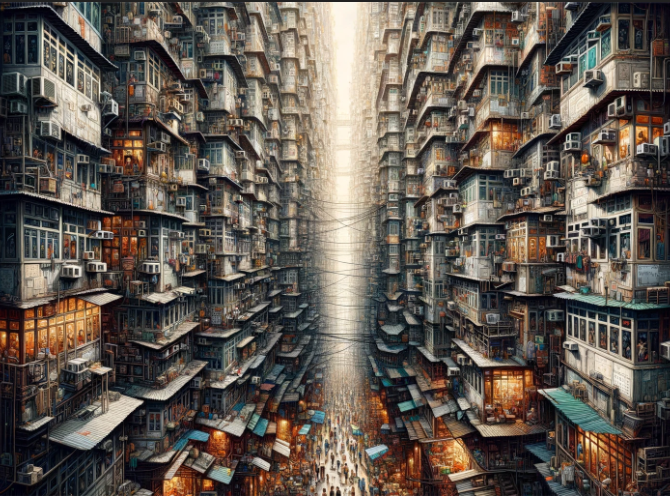Kowloon Walled City, once a blip on the map of British Hong Kong, was an enigmatic city within a city. This densely populated enclave, which at its peak housed approximately 33,000 people within its 6.4-acre boundary, was notorious for its maze-like alleys, makeshift apartments, and unregulated economy. This blog post delves into the life and legacy of Kowloon Walled City, exploring its transformation from a military outpost to a self-regulating urban enclave, and eventually, its demolition.
The Genesis of Kowloon Walled City
The origins of Kowloon Walled City can be traced back to the Song Dynasty as a military outpost. Despite its annexation by the British in the late 19th century, it remained under Chinese control, a status that would lead to its unique legal position in Hong Kong. After World War II, the area became a refuge for squatters from mainland China, a sanctuary that thrived outside the reach of the prevailing government.
Life Inside the Walled City
To the outside observer, Kowloon Walled City was a paragon of chaos and squalor, often described as a den of crime and anarchy. Yet, for those who called it home, it was a bastion of autonomy and community. Despite lacking government oversight, the residents managed to create a functioning internal system that included schools, clinics, factories, and even postal services. This self-sufficiency was supported by a complex, almost organic architecture of interlinked buildings that evolved without adherence to building codes or safety standards.
The Dark and the Light of Kowloon Walled City
While the Walled City was a hub for illegal activities, including unlicensed dentistry and the triad-controlled drug trade, it was also a center of industriousness and entrepreneurship. Factories within the city produced goods ranging from textiles to electronics, operating under the radar of regulatory authorities. This blend of legal ambiguity and economic vitality made the Walled City a unique study in unregulated urban development.
The Demise and Legacy of Kowloon Walled City
The fate of Kowloon Walled City was sealed with the 1984 Sino-British Joint Declaration, which set the stage for Hong Kong’s eventual return to Chinese sovereignty. Both governments agreed to demolish the enclave, a process that began in 1993 and concluded with the transformation of the area into Kowloon Walled City Park. Today, the park serves as a serene reminder of the area’s tumultuous past, featuring elements like the South Gate and educational exhibits that narrate the enclave’s history.
Reflections on Kowloon Walled City
Kowloon Walled City remains a powerful symbol of what happens when a community is left to manage itself, illustrating both the potential for self-governance and the pitfalls of isolation. It challenges conventional notions of urban planning and law enforcement, offering a unique case study on the complexities of human social structures.
FAQs About Kowloon Walled City
Q: Why was Kowloon Walled City demolished? A: It was demolished as part of an agreement between Britain and China in the lead-up to Hong Kong’s handover, largely due to its poor living conditions and lawlessness.
Q: How did people live in such dense conditions? A: Residents adapted to the cramped space by building vertically and creating closely knit communal living arrangements that maximized the limited space.
Q: What has replaced Kowloon Walled City? A: The area where the Walled City once stood is now Kowloon Walled City Park, a public space that commemorates its complex legacy with historical plaques and gardens.
Q: Can remnants of the Walled City still be seen today? A: Yes, parts of the original South Gate and a few historical artifacts are preserved in the park, giving visitors a glimpse into its past.

